Having (hopefully) disposed of the myth that the stamps without controls were in some way different in other respects,
It becomes possible to use remainders in an effort to plate these stamps.
The long strips of 1/6 and 2/6 will be helpful, but vertical pairs are also needed because
the rows do not consistently relate to the penultimate digit of the control number.





Horizontal pairs and even long strips of these with control numbers are available. But not so much as a vertical pair with control numbers.
Source information
Walter Morley writing in "The Fiscal Philatelist" March 1893 said "I have before me what is probably an entire sheet - 100 stamps - formed by 10 rows of 10,
measuring 16½ x 19 5/8 inches from outer edge to outer edge of the stamps, the distance between each stamp being ¼ inch."
He was talking about stamps without controls. Unfortunately he did not trouble to say what denomination stamps these were.
He also makes no mention of one half being inverted relative to the other and a wider gutter between the two panes ! But perhaps that was only the 1/- sheets.
In his 1900 catalogue he lists:
1/- black (50 types to sheet)
1/6 lilac (100 types to sheet)
2/6 blue (100 types to sheet)
4/- pale red (50 types to sheet)
5/- green (100 types to sheet)
He only lists the 1/- value as having tête-bêche pairs.
I now have evidence that he was right on that.
I now have scans of seven of these, but have not seen any of any other values.
Given that all 7 are from different columns of the 10 possible ones, statistics suggest that they may all be from the same sheet.
It is possible, if not probable that it was intended to guillotine between along the gutter between panes to make sheets of 50.
His use of the word 'types' begs explanation. My interpretation would be that all sheets from the printer had 100 stamps.
Some were 100 slightly different stamps, since the values were inserted into the plate by hand, others had the
values inserted by hand into a pane of 50 stamps which was then duplicated to make 100 stamps.
Realistically, because of transfer errors, every stamp on each sheet was different.
For the 1/- value, there are 50 types of hand written values on the first pane, which was then copied to make the second pane.
Since additional flaws were gained in the copying process, there were then 100 different ones. The two panes are distinguishable.
On the 4/-, which appears to have been made first, examples are scarce, but there is evidence that it was produced in the same way as the 1/- plate.
Stanley Gibbons, in their 1899 catalogue state:
"Some values are printed in sheets of 50, and others in sheets of 100, and the figure of value varies in each stamp.
In the larger sheets, the lower half of 50 stamps is inverted with respect to the upper 50;
the two middle rows of the sheet are therefore tête-bêche.
They repeat this in their 1935 catalogue.
This may or may not conflict with Morley describing a sheet of 100 stamps, with no apparent thought of mentioning tête-bêche pairs !
Raymond Lister writing in 1961 says:
"Size of sheets: Some 50, some 100.
Those of 100 are printed with one half tête-bêche to the other, so that a row of tête-bêche stamps occurs in each of them.
Steve Hiscocks (1982) says " ... in sheets of 50 or 100. In the latter case one pane of 50 was printed tête-bêche
below the other and tête-bêche vertical pairs are thus found."
He then goes on to list each value Mint, Used and as tête-bêche pair.
He has clearly interpreted previous writers as meaning that each value was printed in sheets of 50 and sheets of 100.
Alternatively, perhaps he simply wanted to allow for the possibility that they exist.
John Barefoot (2013) says: "The stamps were printed in a sheet with two panes of 50, one pane inverted below the other.
Stamps from the central gutter can therefore be found in vertical tête-bêche pairs; these are only known for the 1/- but others could exist."
Technically this is all correct. It might be better though to start it with "Some of the stamps ..." as some people
might read it to mean that all of the stamps were so printed. If that were true, no stamps would have wide selvedge at the bottom, though some do.
John goes on to say (elaborating on Hiscocks) "The spacing of the stamps in the vertical rows was very close,
virtually touching, so good four-margin examples cannot be found for the issued stamps." I hope I have disposed of that myth, but they are scarce.
I propose to take all this under advisement and look at the evidence.
So far the evidence tells me they were printed in sheets with rows of 10 stamps.
The stamps were printed, like the remainders, with about a quarter inch between stamps both horizontally and vertically, but with wider margins around panes.
As a preliminary analysis, I naturally looked for common flaws, guided by experience with the other private GB telegraph stamps with sheets of 10 x 10.
What I found was surprising, these are more complicated than the others and fell naturally into three groups, each with different characteristics.
Apparent anomalies:
With other private telegraph stamps, with 100 stamps per sheet, if stamps have the same last two digits they should be from the same position and have the same flaws.
In the case of these two, that follows nicely.
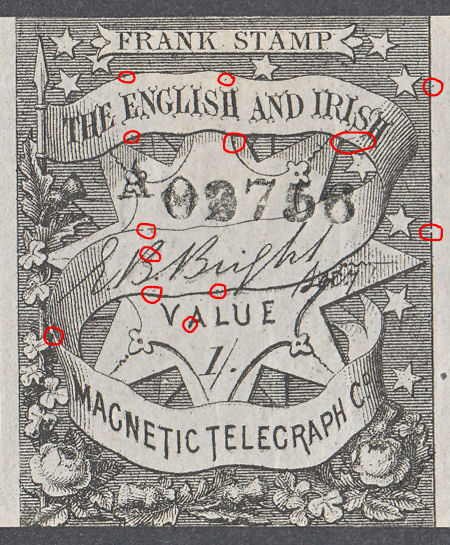
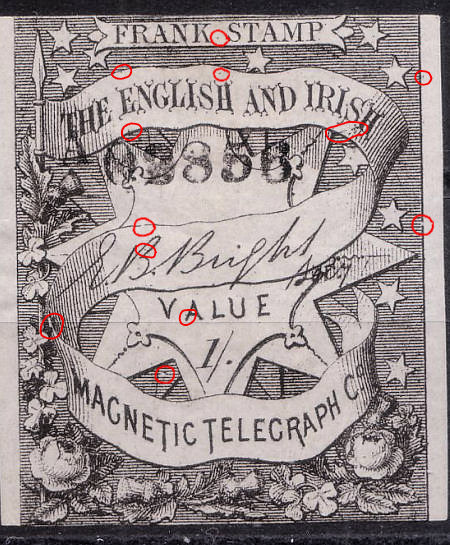
However, it doesn't follow with these two .
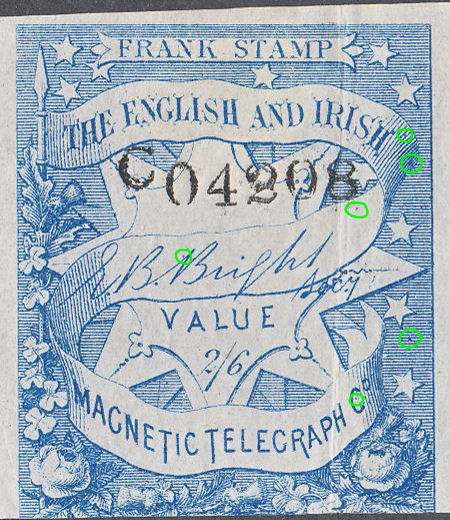
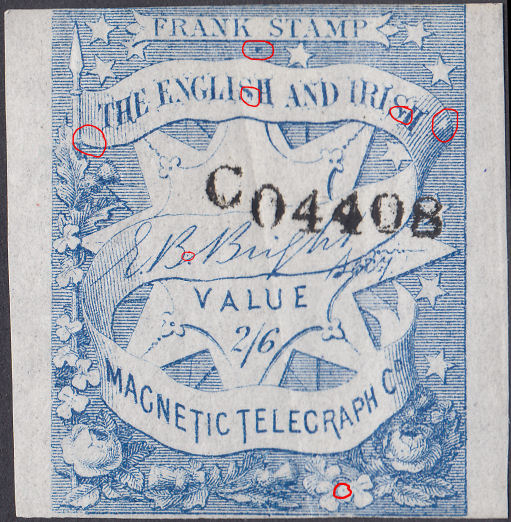
In the end I decided I could not rely on the penultimate digit as an indication of the row. Perhaps these were cut into strips before numbering.
Group 1, just the 4/- value. Because this is the only value known without a letter in the control number, I am assuming it was the first.
It has no flaws matching the other values.
Control 'D' or none.
matches: D12481 and D12491
Group 2 1/-, 2/6 and 5/-, (Controls A, C and G)
A02825 matches A02875 except the inscribed value (different pane)
C02116 DOES NOT match C04366 (value)
C04416 DOES NOT match C04366 (value)
C04161 matches C04261
C04162 matches C04362 (partial doubling)
C04163 matches C04363
C02183 matches a remainder from the top row, but not the pair above
C04143 has some similarities with C04193 but they do not match the pairs above.
C04164 matches a top row remainder
C04245 matches C04395
C04416 matches C04436 (inc. value) but NOT C02116
C04168 matches C04368, a top row remainder and a 5/- remainder.
C04208 and C04288 not matching anything.
G01625 matches G01675 (matching flaws, but DOES not match value)
G01870 DOES not match G01820 (value)
Matches spanning different values:
A02865 has a major flaw that matches C04395, but C04395 does not match C02195
This flaw is on A02765, A02865, C04245, C04395, C04445, G01625, G01675, G01765.
It is not on A02715, A02825, A02875, C02195, C04305, C04365.
It is not seen on any of the 'B' or 'D' controls (see Group 3), but on 8 out of 14 examples ending with '5' of the rest of them, or 57%.
I have no examples ending with '55', but 4 ending with '65' so there may be some skewing.
A02756 matches A02856 and C04436.
Doesn't match C04366
A02694, C04344 and G01684 match.
A02639 part-matches C04369.
A02739 matches C04139 but not G01639.
C02130 matches G01820.
Group 3 1/6, (Control B)
B02732 matches B05582 (inc. value)
B05772 matches B2712 (not value) but not B02872
B02872 matches a remainder in a pair
B05503 matches B02843 (inc. value)
B05773 matches B05513 (inc. value) but not B02873 or B02523
B02523 matches B02873 (not value)
B05583 DOES NOT match any of the above.
B05514 matches B05774 (inc. value) but not B02644 or B02874
B02745 matches a remainder block
B05665 matches B05625 and B02785 (inc. value !) BUT NOT B02875 or B05775
B02876 matches B02726(both) and B05776(not value)
B05697 matches B05777(inc. value) but not B02547 or B02877
Scarcity.
So where do I start ?
Scarcity of the stamps with control numbers will impact on the ease of plating. This table is produced from the ones I have scans of,
though some of the scans are of poor resolution for plating.
| Denomination | Group | Qty stamps | Largest multiple | Lowest control | Highest Control | Sheet numbers represented | *Qty TB | *Blk-4 | *Qty rem |
|---|---|---|---|---|---|---|---|---|---|
| 4/- | 1 | 12 | 1 | 40889, D12373 | D12491 | 408, D123, D124. | 0 | 0 | 26 |
| 1/- | 2 | 26 | 4 | A02619 | A02898 | A26, A27, A28. | 7 | 2 | 31 |
| 2/6d | 2 | 55 | 9 | C02116 | C04499 | C21, C22, C40, C41, C42, C43, C44. | 0 | 0 | 33 |
| 5/- | 2 | 21 | 2 | G01570 | G01870 | G15, G16, G17, G18. | 0 | 0 | 16 |
| 1/6d | 3 | 66 | 9 | B02516 | B05779 | B25, B26, B27, B28, B55, B56, B57. | 0 | 2 | 33 |
Surprisingly, with control numbers, the 1/- stamps are nearly as scarce as the 5/- though many of the 1/6d and 2/6d are in the form of long strips.
* The last three columns are the tête-bêche pairs and remainder blocks of four and singles quantities.
This last is an estimate based on the ratios in two collections for which I have complete data.
L&H refer to a 1/6d with control B02322 having 4mm high control figures. This is lower than any I have seen.
The 4/- value was clearly used the most, but there are surprisingly few that have survived.
That is probably because virtually only mint and remainders have survived.
The last three columns is for the remainders, tête-bêche pairs, blocks of 4 and totals (including blocks and pairs).
This is just what I have scans of, but may at least indicate relative scarcity.
I have more of Group 2 than the others. So it makes sense to start with those.
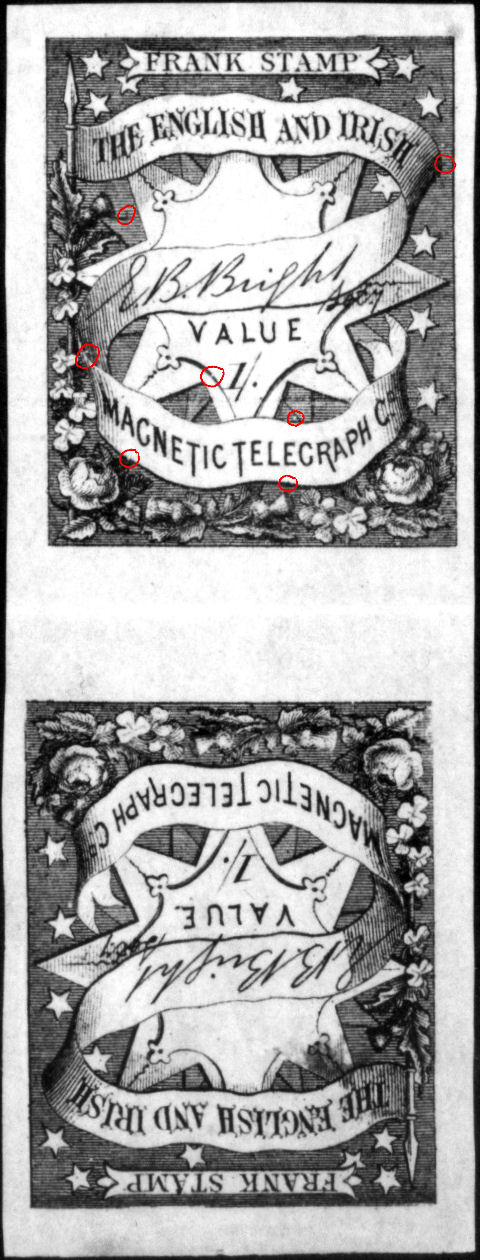 |
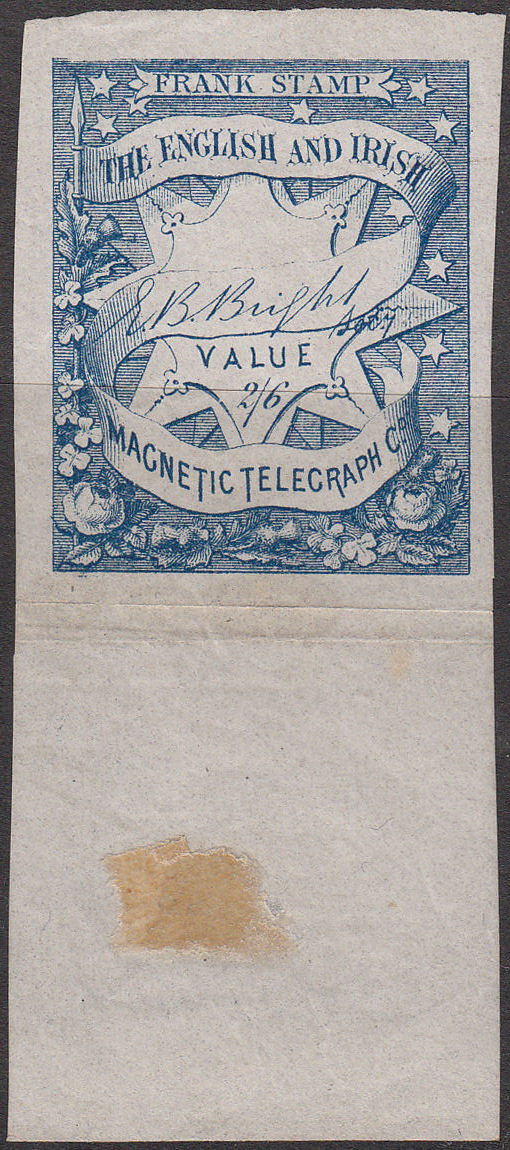 |
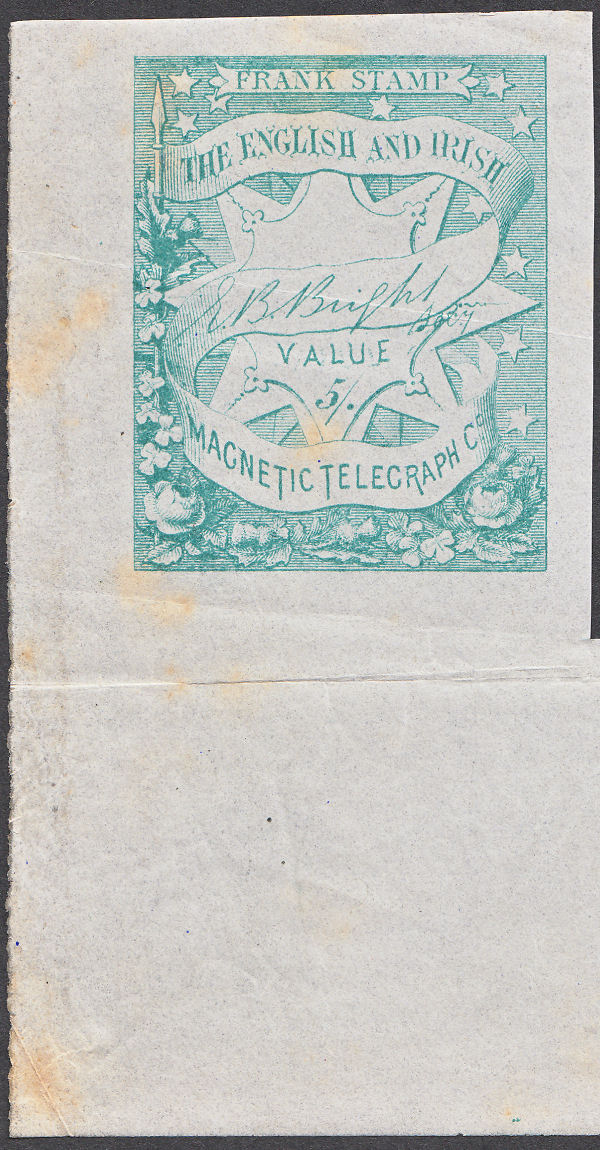 |
| One of mine (ex Dr. Conrad Graham collection). | ||
| 1/- tête-bêche pair as illustrated by Langmead & Huggins, except inverted to compare flaws with the stamp to the right. This also matches A02734. Courtesy of the Great Britain Philatelic Society. |
Comparing to the stamp on the left, part of the base of the '1' can still be seen and it looks like the '/' was re-used. |
5/- remainder from bottom-left corner. This matches G01801 but not G01791 which might seem more likely. |
The 2/6d and 5/- remainders must be from sheets without tête-bêche pairs.
The existence of long strips of the 2/6d, together with blocks of 4 remainders and tête-bêche pairs of the 1/- and will be helpful.
I have created a sortable table of the scans of stamps with control numbers to aid comparison of stamps.
You can mark a row by clicking on it and 'un-mark' it by clicking on it again.
Marking or un-marking it will display the associated image.
'Swap' swaps the images over, 'Step' opens the image following the last one in the list.
Small images can be made bigger by clicking on them, but it will not improve the resolution.
If you check 'Auto Magnify', images will be magnified as soon as they are opened.
Sources:
The LH example is from Colour Plate 2, courtesy of the Great Britain Philatelic Society.
If anyone wants to send me a scan (300dpi or 600dpi)
of new items, I will happily update the information.
The evidence so far is that the transfer block/s were of 5 rows of 10 stamps,
The 1/-, 2/6 and 5/- are derived from a common transfer block, with the 2/6 and 5/- derived from the 1/-.
The 1/6 and 4/- are different from these and each other.
I think the 4/- was made first because of the large numbers used and the one without a letter.
I think the 1/- and 1/6 were made next .
I think the 2/6 and 5/- were made last by clearing the 1/- from a 1/- pane and adding new value figures.
On some of the 2/6 and 5/-, it is possible to see part of the base of the '1' when it impinges on the left frame.
I do not know why they did this, perhaps the original transfer block was no longer available.
I am uncertain as to when the initial letters were introduced, it may be that there were/are other values without it.
Sheets of 100 stamps consisting of 2 different panes of 50 stamps may have been guillotined in half and stacked together before numbering.
I originally assumed that the two panes would have been numbered sequentially before the strips were cut.
This would have made the rows easily identifiable, as with other companies.
The evidence shows that the rows are not readily identifiable and flaws can be numbered as any row.
This indicates that in at least some cases, the panes were cut into strips before numbering.
This seems rather strange, as it would have made the numbering more difficult.
My theory at the moment as to why it was done like that, is that the printers were responsible for cutting the strips for the vending machine,
but, for security reasons, EIM did the numbering.
Breakdown by Groups
according to constant varieties.
Analysis will have to be done independently for the 3 different groups of these stamps.
| Group | Face value | Prefix |
|---|---|---|
| Shortcuts to different groups | ||
| Group 1 | Group 2 | Group 3 |
'5' flaws:
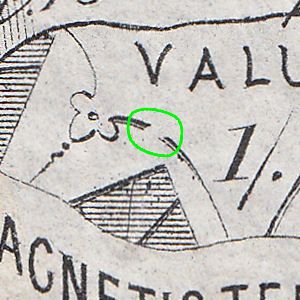
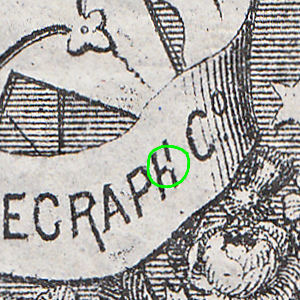
| Broken curved frame below 'V' of 'VALUE'. | ||
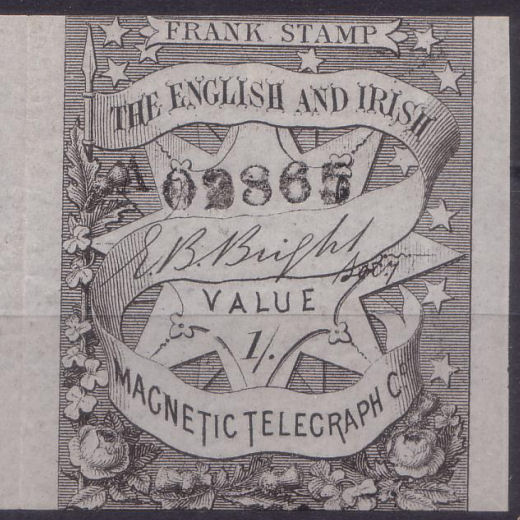 |
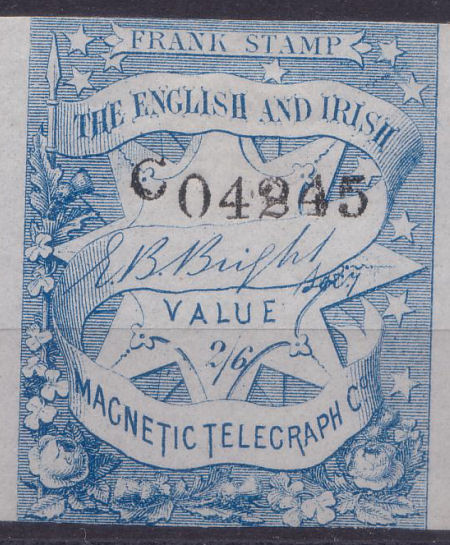 |
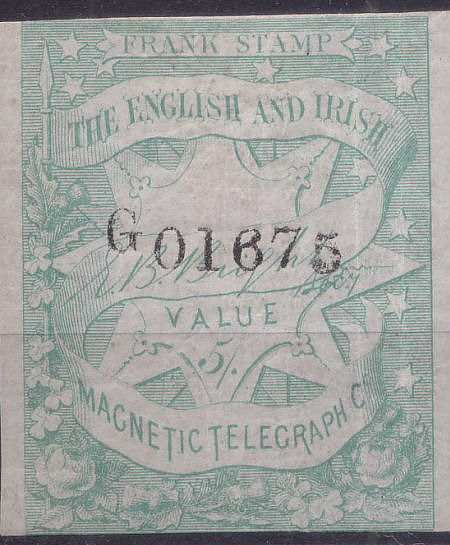 |
| A02865 1/- stamp 65 of sheet 28 | C04245 2/6 stamp 45 of sheet 42, it is also on C04395 2/6 stamp 95 of sheet 43 |
G01625 5/- stamp 25 of sheet 16, it is also on G01675 5/- stamp 75 of sheet 16. |
This remainder block shows the same flaw on the bottom-right stamp.
| These flaws can be seen on: A02694, C04344 and G01684 | This flaw can be seen on A02825 and A02875. The '1/-' matches A02825. |
Row B |
A02825 |
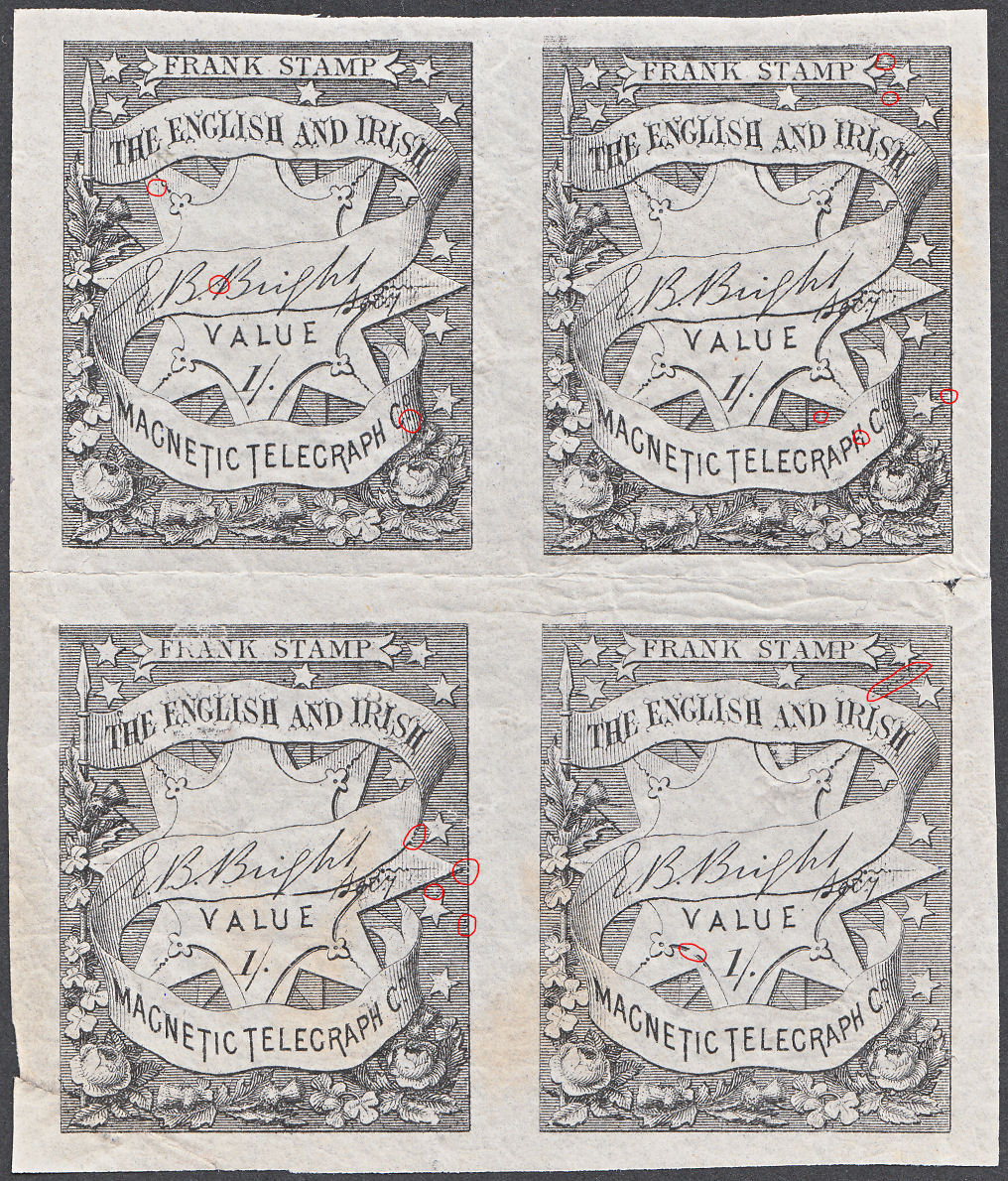 |
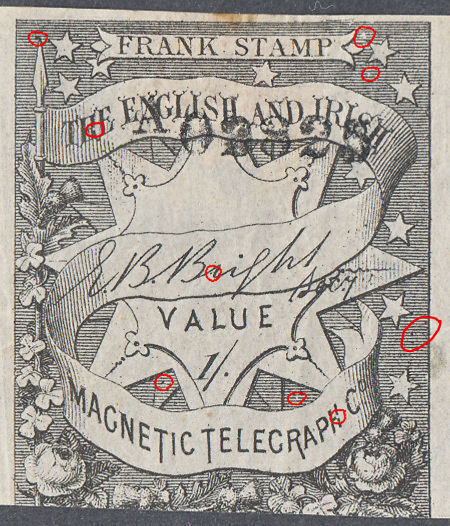 |
||
| Row C |
 |
||
| These flaws can be seen on: A02864 It is not on A02734, A02674, C04434, C04144, C04344, C04364 or G01684 |
This flaw can be seen on: A02865, C04245, C04395, G01625, G01675. |
A02865 | |
| This is a match with: A02674 and a partial match to: C04364 |
These flaws can be seen on C04365 | Row a |
C04365 |
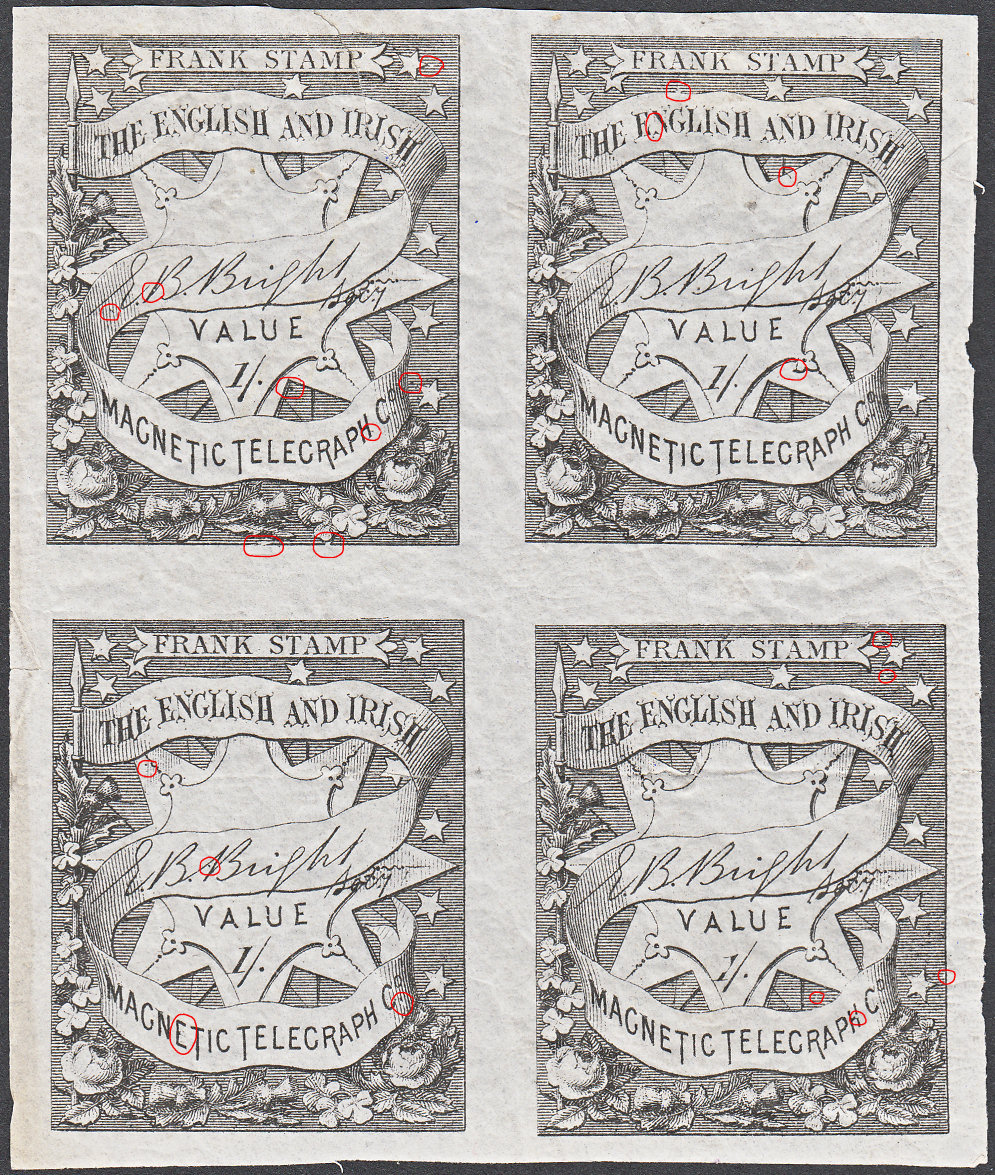 |
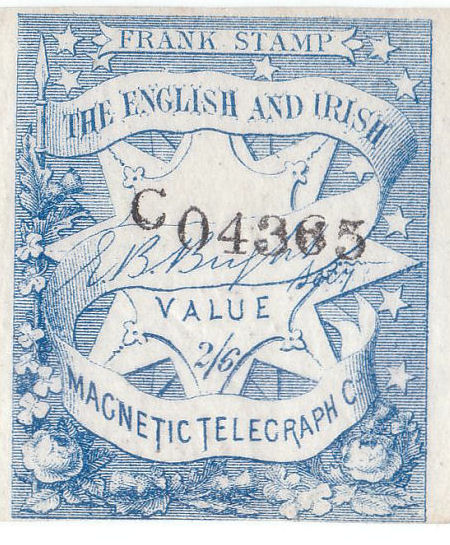 |
||
| Row b |
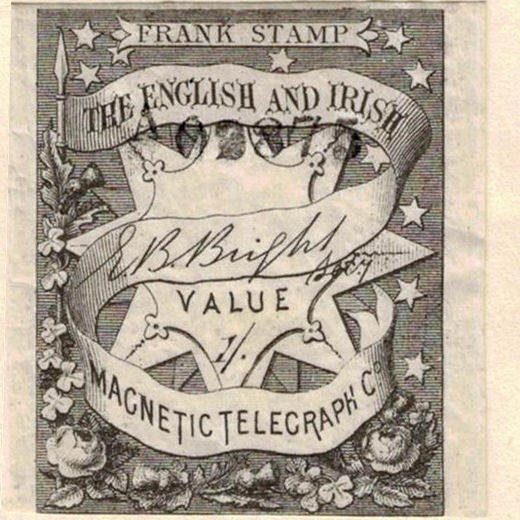 |
||
| These flaws can be seen on: A02694, C04344 and G01684 The 'E' flaw in 'MAGNETIC' is only on A02694 |
These flaws can be seen on A02825 and A02875. The flaw on the '1/-' matches A02875. |
A02875 | |
Tête-bêche pairs.
| These flaws can be seen on A02798 and A02898. | Similarities and differences to the one on the left (A0nn48 ?). | The red flaws can be seen on A02739 and C04139 The green flaw is not on that, but on G01636 ! |
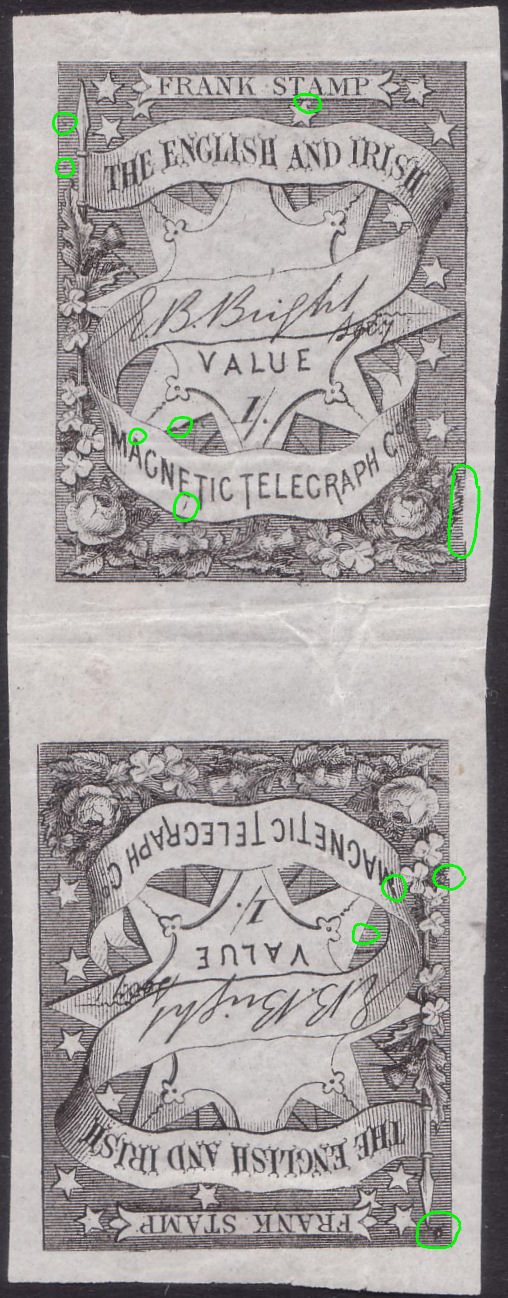 |
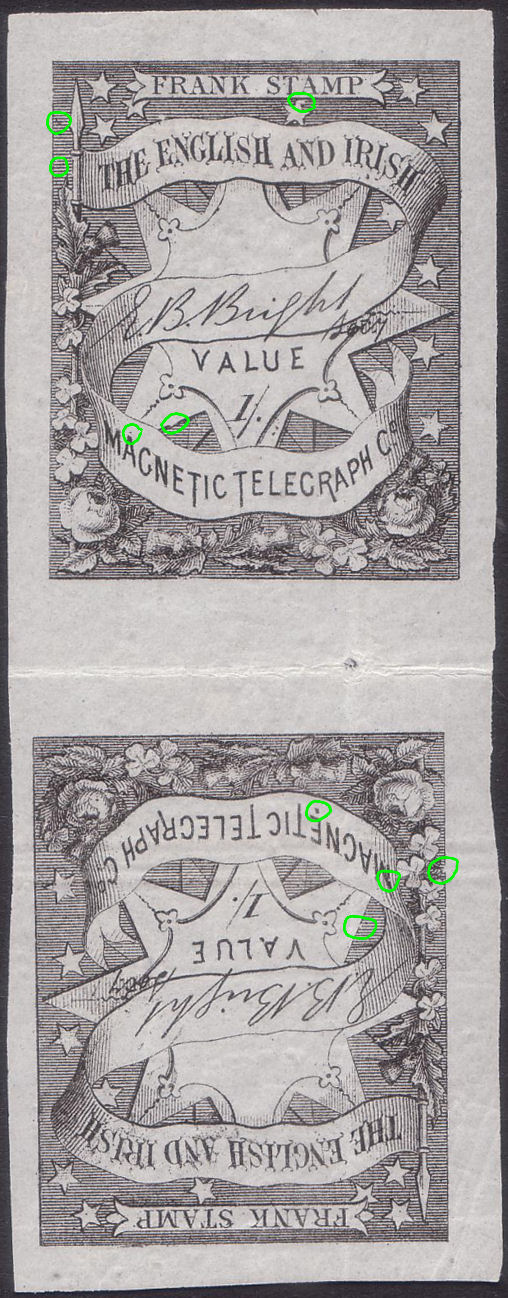 |
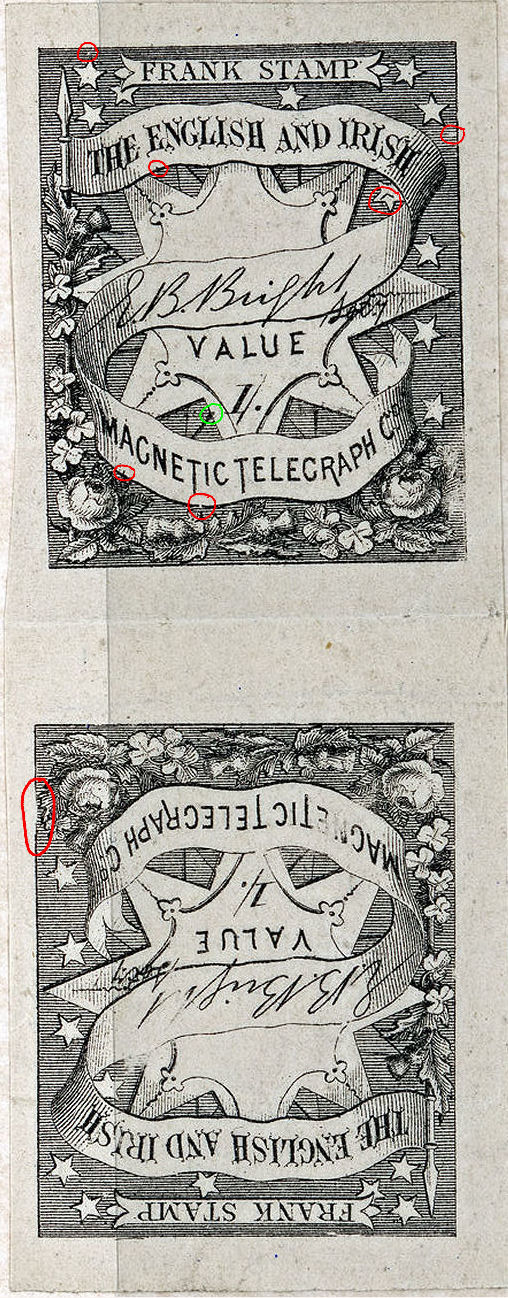 |
| I have not yet found a distinctive flaw on this. Position matches: A02743, A0nn93 |
Similarities and differences to the one on the left (A0nn93 ?). | Ending 42 or 92. The closest I have to this is G01802 |
A pair of tête-bêche pairs from the center of the sheet.
| Column 5 (see C02195) | Column 6 |
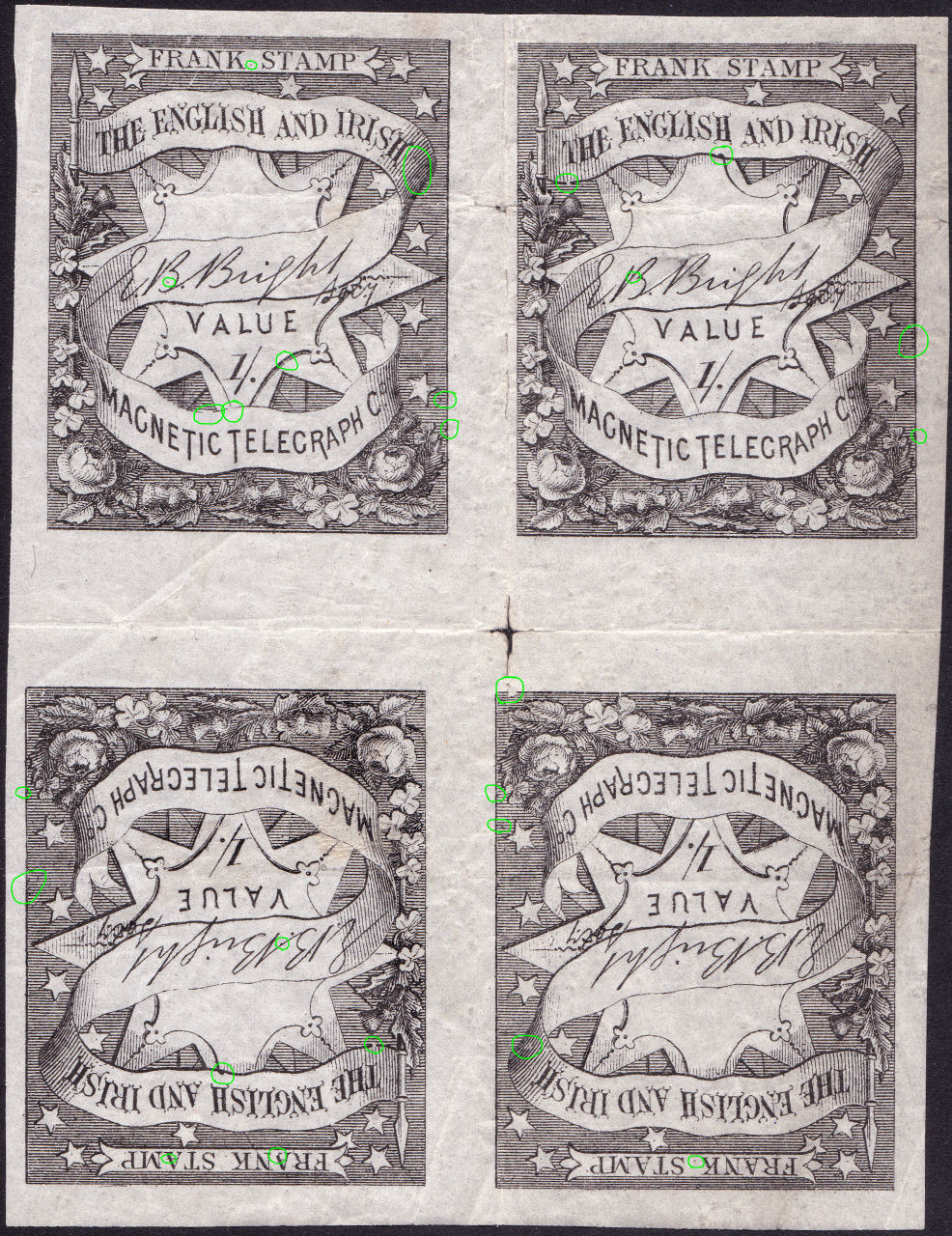 |
|
| Column 6 | Column 5 |
'4' flaws:
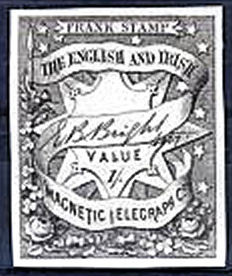 |
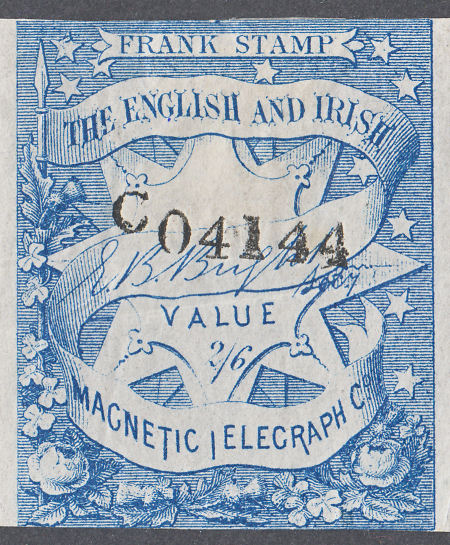 |
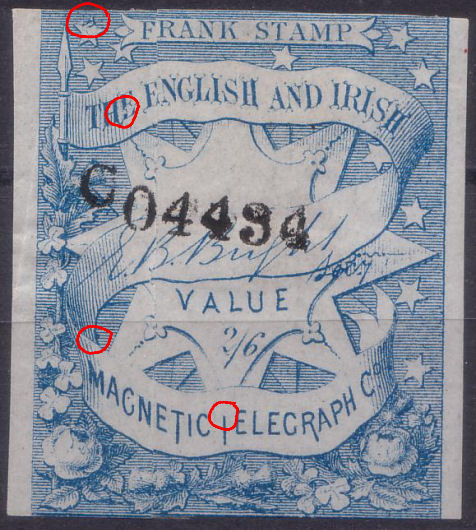 |
| 1/- remainder | C04144 2/6 stamp | C04434 2/6 stamp |
This is also on C04384
C04434 and C04384 make sense as a single location if stamps were numbered sequentially, but C04144 is problematic.
This was my first hint that these were not numbered the same way as other companies did.
I now know that in at least many cases, the panes/sheets were cut into strips before numbering.
Thus, though stamps were (usually) numbered consistently along the strip, the strips could be numbered as any row.
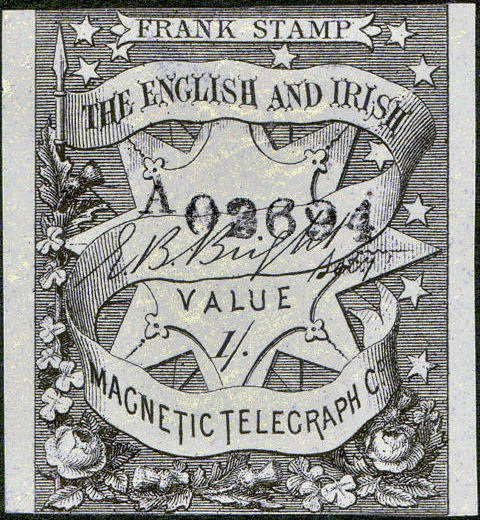 |
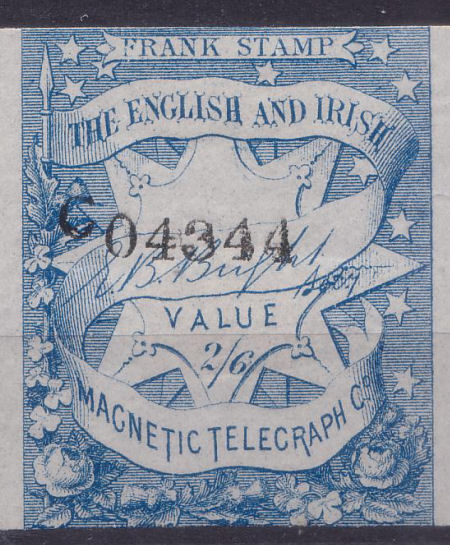 |
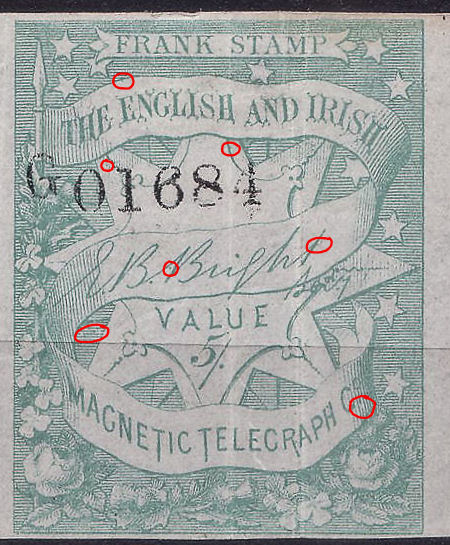 |
| A02694 1/- stamp (note constant 'E' flaw in 'MAGNETIC' | C04344 2/6 stamp | G01684 5/- stamp |
A distinct flaw, all numbered as stamp 5 on the strip, but as rows 9, 4 and 8
| '1' flaws: | '6' flaws: | |
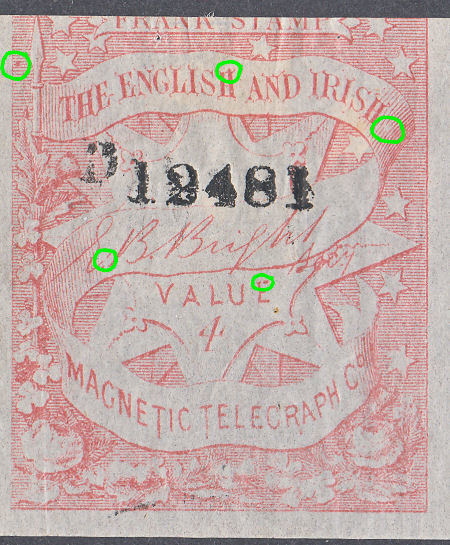 |
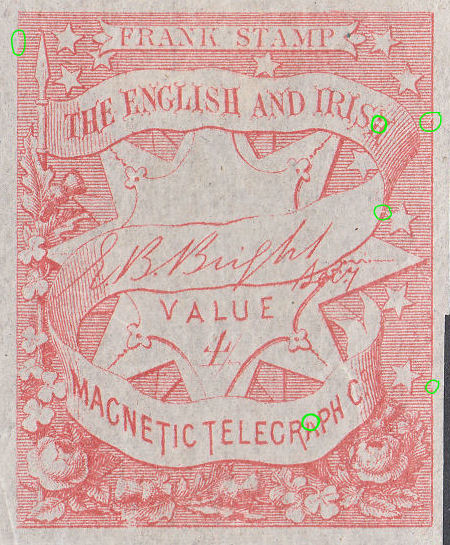 |
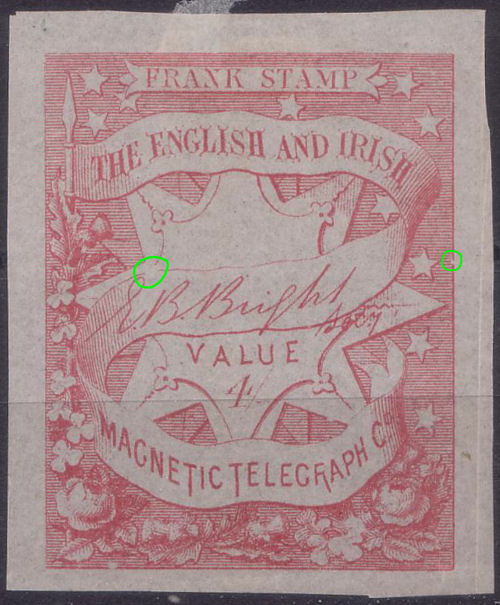 |
| These flaws are also on D12491. | These flaws are on D12396. | These flaws are on D12486. |
The existence of long strips of the 1/6d, together with blocks of 4 remainders will be helpful.
Columns 5 and 6
| Column 9 Scans available: B02639 and B05779 |
Column 0 Position does not match 2810, 5520, 2750, 2770 or 2780. |
There are a small number of matching flaws, but some differences. I have now concluded that they are from different panes. |
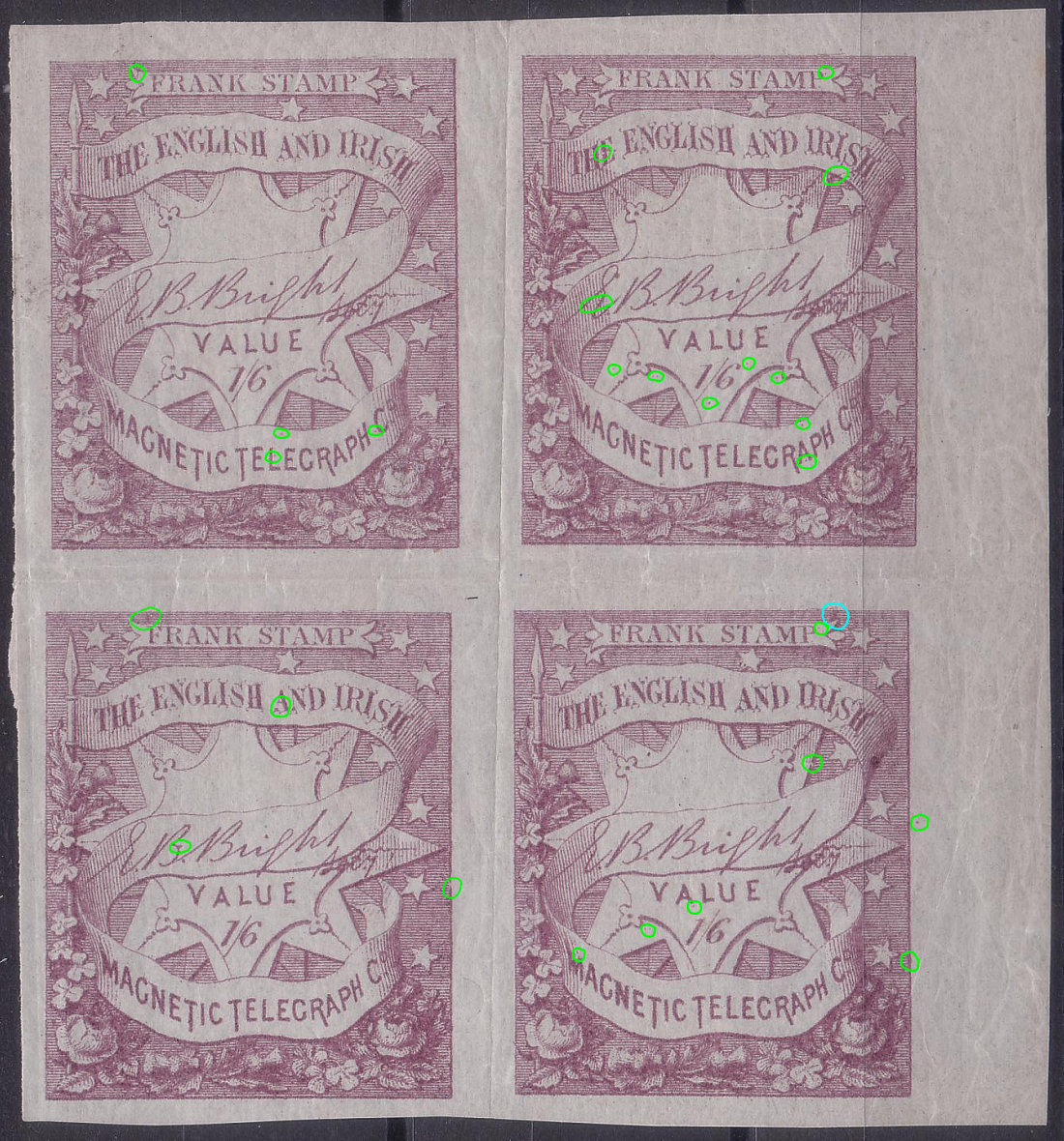 |
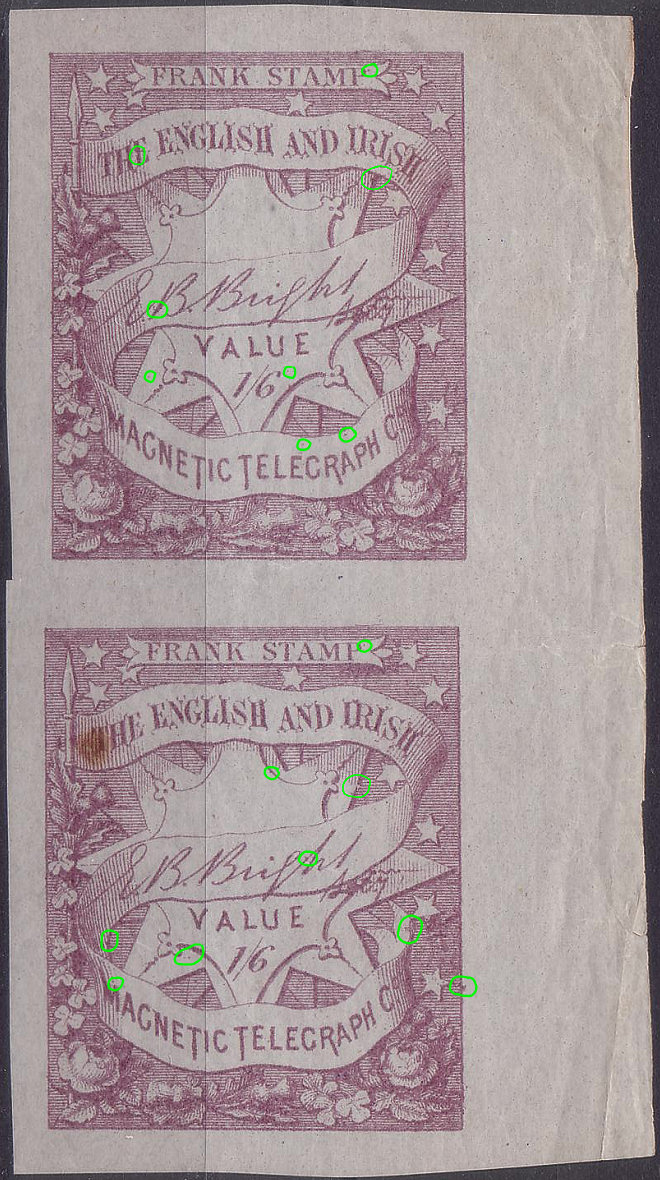 |
|
| Column 9 Doesn't match scans available: B02639 and B05779 |
Column 0 This matches: B02780 but the stamp above does not match B02770 |
Strangely, the bottom matches B02780, but the top matches B02781. However they match better the two from the block of 4. See below. |
| Column 0 from block of 4. |
This matches well, but it is from column 1 ! Without the (pinned) left selvedge, I would have thought these two were numbered vertically upwards. But why does it match ? |
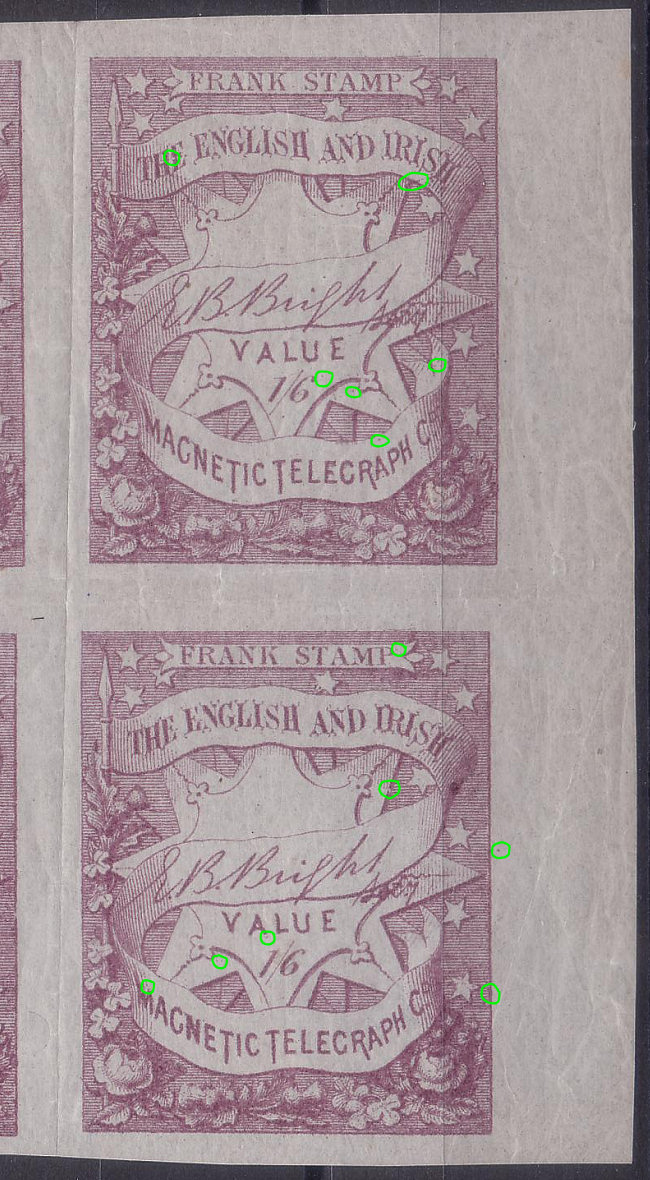 |
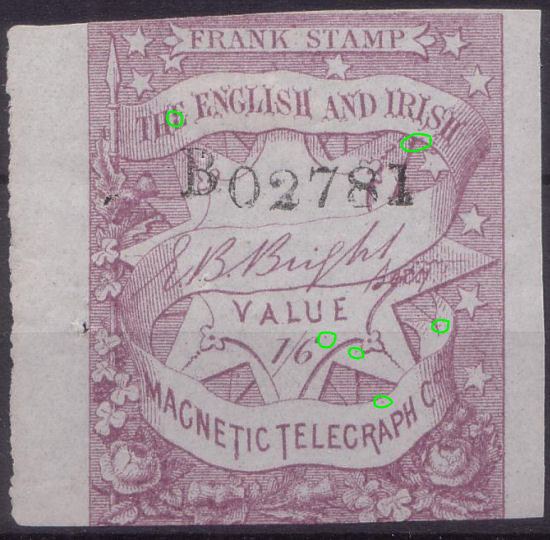 |
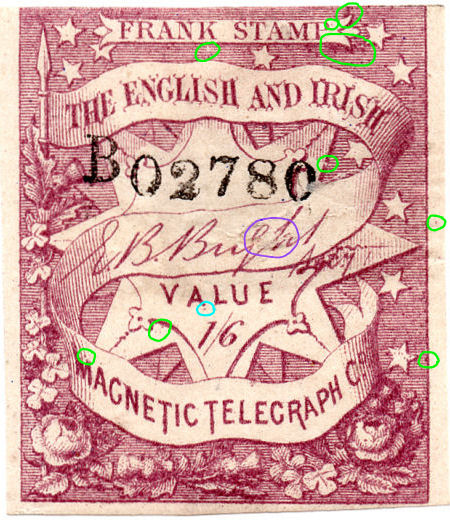 |
|
| Column 0 This matches: B02780 but the stamp above matches B02781 |
Strangely, the bottom matches B02780, but the top matches B02781. These are normally numbered left to right, but these were not ! |
Here is a break-down of the 164 scans I had at the time, by quantities, group and column.
I currently have scans.
Group 1. (4/-)
| Column | 1 | 2 | 3 | 4 | 5 | 6 | 7 | 8 | 9 | 0 | Total |
|---|---|---|---|---|---|---|---|---|---|---|---|
| Qty | 3 | 0 | 1 | 1 | 1 | 2 | 1 | 1 | 1 | 1 | 12 |
These are remarkably evenly spread across the columns. Plating is unlikely to get far without substantial blocks of remainders.
D12481 does appear to match D12491 however.
Group 2. (1/-, 2/6d, 5/-)
| Column | 1 | 2 | 3 | 4 | 5 | 6 | 7 | 8 | 9 | 0 | Total |
|---|---|---|---|---|---|---|---|---|---|---|---|
| 1/- Qty | 2 | 2 | 1 | 4 | 4 | 2 | 2 | 2 | 5 | 1 | 25 |
| 2/6d Qty | 4 | 6 | 5 | 4 | 4 | 7 | 5 | 5 | 3 | 4 | 46 |
| 5/- Qty | 2 | 4 | 0 | 2 | 2 | 2 | 0 | 2 | 2 | 4 | 20 |
| Totals | 8 | 12 | 6 | 10 | 10 | 11 | 7 | 9 | 10 | 9 | 91 |
This gave much better prospects. There were clearly at least 5 or 6 different types for each column.
Group 3. (1/6d)
| Column | 1 | 2 | 3 | 4 | 5 | 6 | 7 | 8 | 9 | 0 | Total |
|---|---|---|---|---|---|---|---|---|---|---|---|
| Qty | 5 | 6 | 9 | 4 | 10 | 8 | 10 | 5 | 3 | 6 | 66 |
Some of the Group scans are derived from low resolution scans of long strips and will not be very good for plating.
The quantities highlighted in yellow when initially analysed for flaws, indicated again about 5 or 6 types per column.
Clearly it was feasible to begin plating. The details are on separate pages:
| Shortcuts to details of plating | |
| Plating-1 (Groups 1 and 2) | Plating-2 (Group 3) |
Further scans invited.
Last updated 8th. November 2023
©Copyright Steve Panting 2012/13/14/15/16/18/19/20/21/22/23 except where stated.
Permission is hereby granted to copy material for which the copyright is owned by myself, on condition that any data is not altered and this website is given credit.